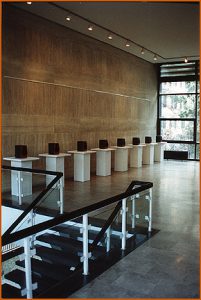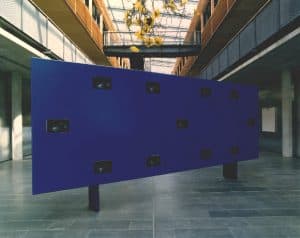The characteristic aspect of the Space-soundObject is a two-dimensional arrangement of the loudspeakers, which radiate sound in one direction. This results in an optimal reception zone in which the visitor can approach and move away from the object. Therefore, Space-soundObjects are usually positioned against a wall.
Figure 1 shows the Space-soundObject ‘Sonic Lines’, commissioned by Nuova Consonanza, Rome in 1998. The 2-dimensional loudspeaker configuration is placed in the shape of an 8-limbed line alongside a marble wall in the foyer of the Goethe Institute in Rome. The loudspeaker configuration of the Space-soundObject is inspired by the specific dimensions of the architectural space. Clearly perceptible ‘line-sounds’ (forming rolling-ball motifs) are counterpointed by internally fluctuating water sounds which represent the liquid, unstable condition of the 8-channel Space-soundComposition.
Figure 2 shows the Space-soundObject ‘Hörbild’ (‘Audible Picture’). The eleven-limbed speaker ensemble is set into a monochrome, blue sound-wall, resulting in an object resembling an image on a panel. The speaker matrix of the ‘Hörbild’ forms the shape of an infinity symbol.
However, the sound does not only move along the path of the infinite bow, but the speaker tableau becomes instead a territory, a construction for sounds on which they spread, compress, evaporate and become solid again. The Space-soundObject was commissioned by the Siemens Arts Program, Munich and was presented for the first time at the Berliner Festwochen 1995 with the 11-channel Space-soundComposition ‘Tableau I-III’. Further works were produced in 1997 for the first exhibition of the Sender Freies Berlin (SFB) sound gallery and for the MusikTriennale Cologne 1997, commissioned by the Studio Akustische Kunst of the WDR (Klaus Schöning).


